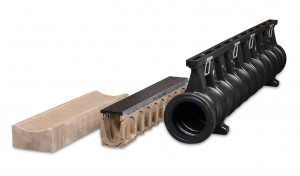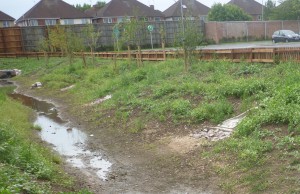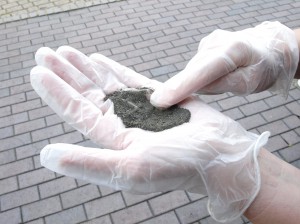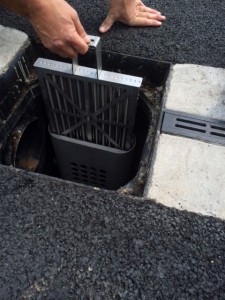Hard and soft integration: Channel drainage use as a link in the treatment train
Martin Fairley, Research Director, ACO Technologies plc
Managing rainfall runoff at or near the surface is a fundamental principle of sustainable drainage enabling management of quantity and quality with parallel improvements in amenity and biodiversity. These are often further coupled to multi-functional space use. The concept of channel drainage has existed for millennia – used variously for excess conveyance or irrigation, it is hardly surprising that their manufactured form progressed from simple concrete dished channels to the wide variety of systems that exist today. When correctly designed and implemented, a channel based design can deliver drainage sustainably and economically – especially in demanding application areas such as brownfield or contaminated land, or where space is at a premium. This article sets out the basis for considering the channel as a key link in the treatment train – helping designers create integrated solutions.
Managing at or near the surface is a SuDS cornerstone – from this simple principle flow a multitude of benefits in respect to surface water management: quantity and quality management options are enhanced by virtue of gravity and other natural processes that are be best exploited from the surface. The passage of water can be dramatically slowed – in stages, with subsequent benefits for runoff timing, rate, and importantly, volume. Naturally, quality is enhanced by this slowing process – lower velocities allow settlement, increase contact time for biodegradation and the full benefit of sunlight can be taken.
The resultant treatment train combines both components and processes. Individual components – the pavement, filter strips, swales and basins all exhibit different capacities for the myriad of physicochemical processes that are at work, and, as such, optimised design is a function of in-depth understanding of site characteristics and the tools and resources available , necessitating a true cross disciplinary approach.
Creating an integrated solution can never be the sole preserve of the planning, design and construction professionals alone though. Sustainability demands a wider stakeholder consideration: ongoing maintenance is critical for continued functionality and will be central to SABs and clients alike in adoptable and non-adoptable situations. Of equal consideration are the objectives of the various occupiers of the spaces created – SuDS has long been heralded as a path to liveability, its natural blue and green capital enhancing our lives as well as the ecosystems we all depend on. What though of the commercial and industrial drivers of our economies – our wealth? For many SuDS might impinge on space use – supplanting profit for trees, car parks for swales and jobs for ephemeral benefits that give way to urban waste repositories.
Development of channel systems over the decades – advancing technology provides a wide range of products suiting a variety of applications
Such situations are entirely avoidable though – SuDS is a dynamic concept; its meaning, implementation and outcomes derived are moving, often forward, reacting to new inputs, shared information and subsequent learning.
Urban commercial centres and by extension industrial centres dominate our economy, we live, eat, drink work, and of course shop and take leisure time in them. Traditionally designed they are rainwater intensive in that the impermeable surfaces shed water and pollutant load with great efficiency to the detriment of our environment and ultimately our water resources. Over the past 3 decades many large surface areas once drained by many gullies, are now drained by a few runs of linear channel drains. The resulting discharge to significantly fewer outfalls combined installation efficiency with reduced excavation – improving construction cost and avoiding water table issues.
Systems developed – highway drainage became a key application area – problematic flat spots were perfectly served by combined kerb drain units in rural and urban locations alike; the latter further benefiting from a reduced potential to interfere with service rich pavement infrastructure . Once heavy, cumbersome, concrete products incrementally developed to lighter polymer substitutes, built in gradients enabled a level surface over large areas, eventually newer materials, manufacturing processes and better hydraulic modelling enabled large higher capacity systems that can span significant areas with single outfalls.
Creating integrated solutions can be facilitated by such characteristics, particularly on problematic sites. For all intents and purposes a channel system conveys water at surface – at least very near it. It is analogous to the conveyance swale in function but for fewer quality benefits. However clients, designers and contractors alike know and understand the components – they are ubiquitously available. Coupled with their newer brethren – the high capacity types capable of spanning complete multi-hectare parking areas, the designer has a linking tool to assist in vegetative SuDS component use.
High capacity linear channels link multi hectare car parks to vegetated systems via multiple shallow invert swale interface components.
Channel outlet inverts are shallow and allow swales, basins or similar features to be constructed within the site – at discrete points often used for tree pits in order to meet local planning regulations, or near site boundaries – in many cases a preferred exceedance design area. The recent development of drain to swale interface products has helped create more aesthetically pleasing results that serve functionally by reducing localised erosion.
The Treatment Train concept follows on from managing on the surface. Early depictions illustrate the gravity driven progression of surface water from source through successive stages, culminating at a larger and lower water body. Notably quantity and quality are served – stages attenuate – slowing passage, infiltration and evapotranspiration losses occur. Nutrients are used, sediments are successively removed. Other processes gradually and synergistically operate resulting in significant improvement over otherwise impaired waters. The designer is less concerned over absolute performance of any individual component as the value of a series of stages is self-evident with rudimentary maths: a 50% reduction at each stage results in an 88% reduction after 3 stages – with additional benefits of mitigating acute incidents.
The treatment train concept is understood and works. On the typically smaller sites that represent urban commercial /industrial though – in many case sub 5ha or smaller still, the potential to implement gravity driven stages is dependent on gradient. Again careful design and management on surface leverages what is available.
Delivering water quality benefits requires some understanding of the pollutant hazard. What is apparent is that much pollution in urban runoff is diffuse in nature. Urban diffuse pollutants take various forms but much good will be done by managing the particulate load in runoff. Clearly automotive vehicles present a major category of polluter – particulates occur not only in combustion processes but as a consequence of any friction between any surfaces – of which there are many examples.
Sediments in urban runoff transport many highly polluting substances
Of particular interest is the sizes of particles under consideration – perhaps counter intuitively, small particles present large overall surface area – which drives chemical reactive potential. Smaller particles are readily mobilised by lesser energy in the rainfall event – meaning the often frequent showers we enjoy deliver surprisingly large portions of pollution to receiving bodies. Small particles are inherently less able to settle – sub 100 micron particulates describe a range of particles that not only readily attach to or absorb key pollutants, but are increasingly mobile as size decreases.
Managing on the surface and through treatment trains couples with maintenance in obvious ways. Sediment is deposited at each stage – it is visible. On, or near the surface many beneficial processes occur – volatilisation, photolysis and biodegradation variously occur, though to enhance the treatment train it is necessary to remove as much matter as soon as possible from the run off. Carefully designed channel systems help achieve this goal. Filtration units can be placed in line with outlets preventing subsequent blinding or receiving media.
In-line filters offer effective pre-treatment protecting receiving SuDS
Where pollution potential is highest conveyance via the channel to a high performance proprietary product targets individual pollutants – with defined removal capacities the likely shallow inverts allow further vegetative treatment along the chain as required.
Helping to create integrated solutions may be seen as an outcome based, multi-disciplinary effort requiring careful consideration of throughout the many stages of a project lifecycle and moreso, consideration of key stakeholder objectives. A sustainable drainage system might take on many forms – but at its heart is the notion of system. This paper portrays the role for channel drainage in facilitating management near the surface and connectivity between components.



